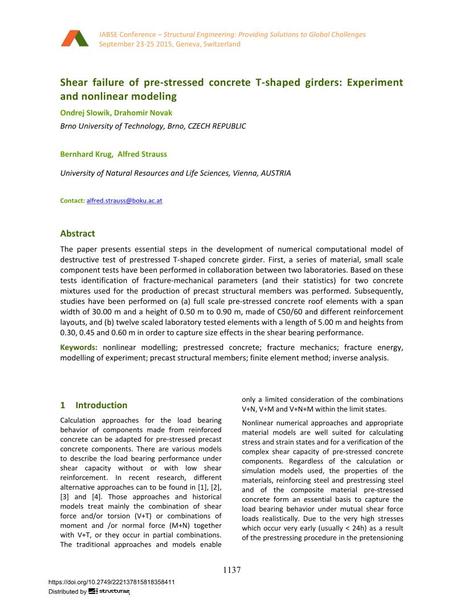Shear failure of pre-stressed concrete T-shaped girders: Experiment and nonlinear modeling

|
|
|||||||||||
Bibliografische Angaben
| Autor(en): |
Ondřej Slowik
(Brno University of Technology, Brno, CZECH REPUBLIC)
Drahomír Novák (Brno University of Technology, Brno, CZECH REPUBLIC) Bernhard Krug (University of Natural Resources and Life Sciences, Vienna, AUSTRIA) Alfred Strauss |
||||
|---|---|---|---|---|---|
| Medium: | Tagungsbeitrag | ||||
| Sprache(n): | Englisch | ||||
| Tagung: | IABSE Conference: Structural Engineering: Providing Solutions to Global Challenges, Geneva, Switzerland, September 2015 | ||||
| Veröffentlicht in: | IABSE Conference Geneva 2015 | ||||
|
|||||
| Seite(n): | 1137-1147 | ||||
| Anzahl der Seiten (im PDF): | 11 | ||||
| Jahr: | 2015 | ||||
| DOI: | 10.2749/222137815818358411 | ||||
| Abstrakt: |
The paper presents essential steps in the development of numerical computational model of destructive test of prestressed T-shaped concrete girder. First, a series of material, small scale component tests have been performed in collaboration between two laboratories. Based on these tests identification of fracture-mechanical parameters (and their statistics) for two concrete mixtures used for the production of precast structural members was performed. Subsequently, studies have been performed on (a) full scale pre-stressed concrete roof elements with a span width of 30.00 m and a height of 0.50 m to 0.90 m, made of C50/60 and different reinforcement layouts, and (b) twelve scaled laboratory tested elements with a length of 5.00 m and heights from 0.30, 0.45 and 0.60 m in order to capture size effects in the shear bearing performance. |
||||
| Stichwörter: |
Finite-Elemente-Methode (FEM) FEM
|
||||
